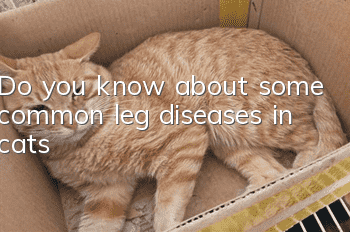Do you know about some common leg diseases in cats?

If you find that your cat is lame, you should check it immediately
Do you know about some common leg diseases in cats? Cats often jump up and down and are very active. For example, when you come in the door, they will Like a gust of wind passing by you as a greeting, it also shows that they are different from other animals in their agility. The cats in our impression are all agility masters, but in reality there may be exceptions. If the cat does not If it is so flexible and limping towards us, there may be something wrong with its legs.
1. What should I do if my leg is lame?
If you suddenly become lame, especially after strenuous exercise, you may be injured. Injuries can range from mild to severe. In mild cases, they may only be soft tissue injuries, including muscles, tendons, ligaments, etc.; in severe cases, they may be fractures, joint dislocations, ligament ruptures, etc. A rupture of the anterior cruciate ligament of the knee joint is a relatively common example of extreme joy leading to sorrow. Of course, it is possible for a person to be lame if his claws are cut by a stone.
While checking the cat's injuries, it is best to gently touch the cat's body with your hands to see if there are any fractures. If the cat's legs are injured and cannot move, it is likely that the bones have been injured. If there is a bone problem, please do not move the cat casually. You should quickly find a large wooden board, then transfer the cat smoothly to the wooden board, and use wide cloth strips to stabilize it. , and then rush to the hospital for treatment.
If it is only a minor trauma, debridement, disinfection, hemostasis, and bandaging will suffice. For cat trauma debridement, you can use 3% hydrogen peroxide, wrap the tourniquet twice around the heart, 3-4 cm away from the wound, and tie a knot. Then use some trauma ointment on the cat.
Notes:
① Do not move the injured leg casually, as it may make the injury worse, and the pet may be bitten due to pain.
② If your legs are swollen or you cannot reach the ground at all, you need to seek medical attention immediately.
③ If the lameness is only slight, you can try to limit the pet’s movements and let it rest to see if it gets better. If the pain persists for more than 24 hours, you need to go to the hospital.
④The doctor will usually perform palpation and may need to take X-rays to determine whether there are fractures, joint dislocations and other problems. Depending on the severity of the fracture, a referral to an orthopedic specialist for surgery may be necessary. Soft tissue injuries may require the use of anti-inflammatory painkillers and strict "bed rest."
2. Infection or other inflammation
If lameness does not occur after strenuous exercise , be careful about other possibilities.
1. Infection caused by injury
For example, when the skin is broken, bacteria invade, causing pustules, or joint infection, etc. For cats that go out, they are bitten by other stray cats or wild animals, and then formPustules are common.
Solution: Seek medical attention promptly. The doctor will check your temperature to see if there are any remaining wounds on the skin, and may need X-rays and blood tests. For suspected pustules, a needle sample may be needed to see if there is infection.
2. Systemic infection
For example, diseases caused by certain ticks. Lyme disease is a more typical one. Different joints may have alternating pain, accompanied by loss of appetite and energy, fever, difficulty breathing, etc.
Solution: Take the 4Dx SNAP Test, a test that includes heartworm and three other tick diseases. X-rays and blood tests are also needed to rule out other possibilities.
3. Chronic arthritis
It is relatively common, especially in older or obese dogs. Lameness from chronic arthritis worsens slowly, but injuries can also cause arthritis to worsen suddenly.
Solution: After ruling out other possibilities, use joint supplements. If it is really painful, you may need to take painkillers. For details, please see Pet Arthritis
4. Immune arthritis
It is relatively rare, but it cannot be ruled out.
3. Spine problems
Pets can also have intervertebral disc problems, especially A dachshund with an extremely long back. Damage to spinal nerves caused by disc herniation or spinal injury can cause loss of movement in the hind legs, loss of pain, and even the inability to urinate normally. Nervous system problems and skeletal muscle problems are difficult to distinguish from the owner's perspective.
Solution:
①Be sure to seek medical treatment in time.
②The doctor will do a neurological examination and X-rays to identify the affected spine location.
③If conditions permit, myelography, CT or MRI will have more accurate results.
④ Depending on the severity of the condition, the doctor will choose drug treatment or surgical treatment.
4. Some common diseases of fractures
1. Paper bone syndrome
Muscle disease Nutritional secondary hyperparathyroidism is more commonly found in kittens between 6 and 8 months old. It is caused by an imbalance in the secretion of parathyroid hormone due to an imbalance in the calcium to phosphorus ratio in the diet. It is easy to deform and break, also known as "paper bone disease".
2. Dislocation
Abnormal movement of the relative positions of the two bones in the joint is called dislocation. The symptoms are sudden pain and the inability of the limb to bear weight. When a dislocation occurs, you should seek medical attention as soon as possible. Your veterinarian can correct the bone back to its original position after administering appropriate anesthesia.
3. Osteoarthritis
Trauma leads to bacterial invasion of joints, joint dislocation, joint infection, rheumatism or related diseases caused by old age.Degeneration of joint cartilage is a possible cause of arthritis. The joints will be swollen, painful, red in appearance, stiff, lame, and even have fever. Veterinarians will treat them with anti-inflammatory drugs.
4. Skeletal abnormalities
Except for polydactyly, congenital skeletal deformities in cats are uncommon; femoral joint atrophy and patellar luxation are only seen in purebred cats. Occasionally, cats with skeletal abnormalities are likely to develop osteoarthritis and have symptoms of lameness.
- What cat did the Ragdoll come from?
- What to do if your cat has ear mites
- What does the silver gradient look like with a blue cat?
- Which cat is best to breed with Siamese cat?
- Why do cats roll in catnip?
- Can cats eat kelp and pork ribs soup?
- Somali cat personality traits
- How to wash a cat's paws if he steps in poop
- What are the symptoms of vitamin B6 deficiency in cats?
- What are brain tumors in cats? What should I do if my cat has a brain tumor?



